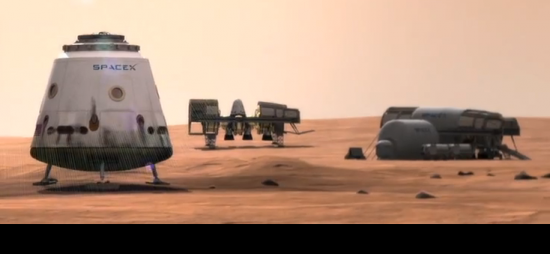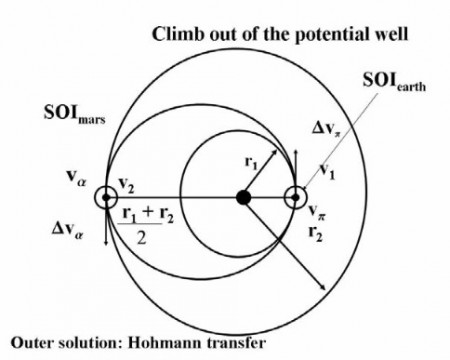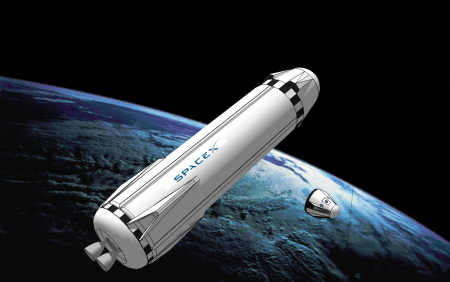June 12, 2016 – To reach Mars from Earth requires a flight of between 54.6 and 401 million kilometers (34 and 249 million miles). The average distance between the two equals 225 million kilometers (139 million miles). The fastest transit by any Earth-launched spacecraft bound for Mars was Mariner 7 with a flight time of 131 days. Mariner 9 took 167 days and was the first spacecraft to successfully go into orbit. Both flights were accomplished because their launch windows were planned at a point in time when the two planets were favorably positioned.
When you think about the two planets’ orbits, Earth’s follows a path that takes it as close as 147 million and as far away as 152 million kilometers from the Sun. Mars orbit varies from 207 million to 249 million kilometers from the Sun. A Martian year equals 687 Earth days. Mars is at opposition to Earth (that is closest in approach) approximately every 780 days.
To come up with an optimal plan in sending humans to Mars celestial navigators use the Hohmann Transfer Ellipse. Massachusetts Institute of Technology offers open courseware on the subject so you too can plot an interplanetary trajectory between Earth and Mars. The Hohmann transfer takes into consideration from launch time to arrival time the relative change in position of the two planets. If so inclined you can apply the mathematical formulae yourself using the information supplied in the open courseware to plot the journey.
There are many variables to achieving a successful Hohmann transfer. One has to consider the size of the object being sent between Earth and Mars. One has to consider the amount of fuel and the needed heavy lift capability of any rocket attempting to escape Earth’s gravity well. And then one has to consider fuel requirements within the payload weight for planned deceleration upon reaching the proximity of Mars.
Well Elon Musk has been thinking long and hard about this subject ever since he launched SpaceX, his private rocket company. Musk has repeatedly stated a goal to establish a permanent human presence on Mars turning us into an interplanetary species. He sees this as insurance for our survival. And he also sees it in the same pioneering spirit at that done by the first European colonists setting out across the Atlantic Ocean to the Americas starting in the 16th century.
But Musk knows something that those Europeans didn’t. He has a vast accumulation of scientific knowledge about Mars from four decades of robotic missions to the planet. Mars has been mapped and measured. So as difficult as the journey and settlement may be he believes we start out on the voyage with some advantages over those earliest Atlantic voyagers.
He also has a plan to send equipment ahead of colonists to adequately prepare a site. And he wants to start making those preparations as early as 2018 and thereafter approximately every two years until enough resources are put in place on the Martian surface to ensure the success of the operation. This sounds a lot like Mars One, the Dutch-based initiative to send four people selected from hundreds of thousands applicants on a one-way voyage to Mars. And in fact Musk has provided Mars One with moral support to date. Engineering students at Massachusetts Institute of Technology, who have studied Mars One’s announced plans, however, have come to a conclusion that within a short period of time all Mars One colonists would die.
Which brings us back to the plans Musk has revealed to the press in the past week. Here is the timeline:
- 2018 – SpaceX launches Red Dragon using Falcon Heavy and lands on Mars.
- 2020 – company sends two Dragon spacecraft to Mars loaded down with all kinds of experiments.
- 2022 – company launches Mars Colonial Transporter, seen below, a spaceship designed for interplanetary travel.
- 2024 – first human colonists would be sent to Mars on board the Transporter to arrive in 2025.
Musk acknowledges there is a significant amount of infrastructure to be built to ensure his plan’s success. He also intends to reveal more details in September. But it should be pointed out that any comparison between the 16th century Atlantic Ocean voyages of Europeans to the Americas is fanciful to say the least. Those voyagers could drop a net into the Atlantic and catch fish. Those voyagers didn’t have to carry the atmosphere along with them. Those voyagers at worst were no more than a month away from their point of origin. And those voyagers also found stepping stones along the way where they could make resupply stops. And when they arrived their destination wasn’t a barren landscape, but a verdant land filled with food and resources with which to build.
Musk talks about a “self-sustaining city on Mars.” But what he doesn’t talk about, or is keeping under his vest, is the complexity of infrastructure he and others will need to deliver to achieve his vision.
As much as I admire the ambition I cannot wonder why Musk is not considering a more nuanced and safe incremental strategy. I have stated repeatedly on this blog site that to reach Mars humans need to establish way stations along the way. The most obvious first way station is the Moon where a permanent habitation and human presence could be established a mere 3.5 days away from Earth should something go wrong. Everything needed for Mars could be built and tested on the lunar surface and in the near-lunar environment. We could build self-sustaining space habitations in lunar orbit. We could move them to Lagrange points near the Moon to ensure that they are indeed self-sustaining. Then we could launch them into stable solar orbits between Earth and Mars. Bigelow Aerospace with its inflatable habitats similar to the one currently undergoing tests on the International Space Station, is positioned to deliver the type of structures that could serve us well for a lunar colony, deep space habitat, and eventually a home for human Martians.
Musk in talking to the press describes his Martian adventure as “mind blowing….I’m so tempted to talk more about the deails of it. But I have to restrain myself.” As much as I admire his boyish enthusiasm for the enterprise I believe the Musk plan as revealed to date is no better than Mars One. Maybe he will reveal enough details in September to make me revise my opinion, but I am highly skeptical.













